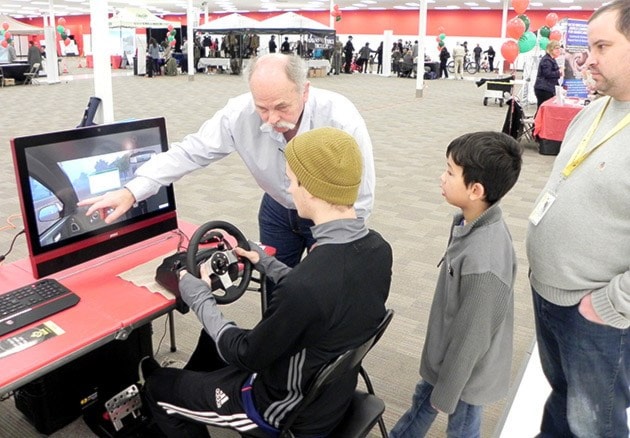There is no safe way to use a handheld device while driving a car.
Not at a stop light. Not in a parking lot. Not on the highway at top speeds.
Never.
And to drive that message home, ICBC has been using a distracted driving simulator at public and private events throughout the province. Mike Weightman, regional road safety coordinator for ICBC, had use of the simulator over the last week. He brought it along to Saturday's Public Safety Expo at Cottonwood Mall, where about 100 people opted to give it a chance.
The simulator operates like a video game, but with gas and brake pedals, and a steering wheel outfitted with turning signals and buttons to help the driver look left and right. A monitor displays the road ahead, complete with distractions.
Most of those who tried the simulator realized just how hard it is to drive without focusing on just the road.
"What we found this weekend was that the environment (at the expo) was not that different than having a carload of kids in the car, and people talking to the driver," Weightman says. "It's not just the device in the car, it's the passengers, the screaming children. There's a lot going on and you don't need another distraction."
In the simulated game, the driver picks up a friend who chats away from the passenger seat, and asks the driver to make a call while driving through residential and business areas. There are pedestrians to watch for, directions to follow, children and bouncing balls to avoid, pets, and more.
It's just like real life. Except in this game, the people injured by bad driving don't die.
Distracted driving is the second highest cause of deaths on B.C. roads, currently. It's topped only by speed, and just edged out impaired driving.
"We're having a hard time reaching some people," Weightman says, even with the increased fine and fee structure. "Some people just don't think it can happen to them."
There are 800 crashes a day on B.C. roads, and most of them are caused by distracted driving. Most of those distracted drivers are distracted by handheld devices, but there are other distractions that can make drivers lose their focus. The list of things people do behind the wheel includes grooming, eating and drinking, dealing with children, and even reading maps.
People just aren't looking at the road like they used to, Weightman says.
At the expo, he said some people did try to use the phone while 'driving' the simulator.
"A lot of people didn't go further than trying to dial," he says. "It was a really good reality check."
The other event Weightman took the simulator to this week was an employee health and wellness fair at Chilliwack General Hospital. He noticed all the doctors who tried the simulator completely avoided the phone.
"It was noticably evident that they just left the phone alone," he says. "They wouldn't even engage in the phone. They've seen what can happen."
The expo provided a good opportunity to open up the dialogue about road safety among families, he said. And he has some advice for parents whose teens are just starting to drive.
"If they're out at night, and you know they should be driving, don't start phoning them to find out where they are," he says. "You're going to encourage them to pick up the phone, don't even give them the option."
ICBC has just two simulators, one for the Lower Mainland and one for the rest of the province. Weightman is looking forward to a chance to bring it back to Chilliwack to allow more drivers, and potential drivers, to try it out.
